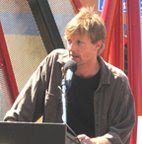As I start working on the pieces for the week's street painting events (I'm actually doing two different Michelangelo pieces, a small sample for the local morning TV spots and the full scale piece during this weekends' Corso Degli Artisti) I've been thinking about the usual questions I get when working on large, mural scale painting in chalk, usually on my hands and knees in the street:
How do you do this?
What happens when you're all done with it?
How do you feel when they wash it all away?
Do they pay you to do this?
How do you make any money doing this?
This year the answers will be a little different because I am the featured artist of the event, which means I'm getting a fee to do a piece on panels (instead of the pavement) that will be mounted and permanently displayed in Little Italy neighborhood when its done.
As this is the first time in five years of participation that I'm being directly paid to chalk in Little Italy, I wouldn't say that "I make money doing chalk." But given that my contracting business revolves around creating custom artwork of many kinds, from custom handpainted wall murals to unique "faux" painted and plaster finishes for interior and exterior surfaces, street painting is a great way to meet people interested in unique custom art and spread the word about my custom art services, which I feel are unique in their blend of design experience, art and architectural history, technical skills and prodcution experience. (See some of my past custom art projects at www.john-scenic.com).
When I develop a custom art project, often the experience that I provide to the the clients and the working dynamics I make possible for the designer(s) are just as significant to the success of the project as the actual artwork. Street painting is similar in that its as much a performance art project as a visual art one, taking place over a set period of time for a live, often interactive audience.
So really, street painting to me is practice: practice drawing & painting on a large scale, practice communicating with people, practice sharing knowledge. I particularly enjoy the practice of working from the masters (like Botticelli or this year's Michelangelo) because there is always more to discover in their work the more you study it, and more to share with people who ask.
My favorite question is the first one ("How do you do this?") because the answers are always new, yet build on the previous ones, in the same way that every mural or faux finish that I do is differnet than everything I've done before and lays the ground for the next one at the same time. (I teach this "method" throughout my mural and faux finish classes at the San Diego Finishing School).
This year my how-tos will be based on the methods Michelangelo himself used. To find out more, check out KUSI morning show from 7.30-9.30am tomorrow October 3, 2006 to see me start a small Michelangelo in chalk, and then check back here tomorrow for a "transcription" of the process. I will continue the piece on Fox 6 Thursday morning and finish on NBC Friday morning before starting the big one on Saturday morning in Little Italy.
FlySFO
-
As a contract front end developer, I enhanced several features on the way
to the release of the new San Francisco International Airport site.
6 years ago



No comments:
Post a Comment